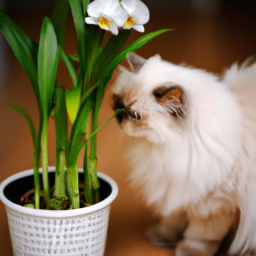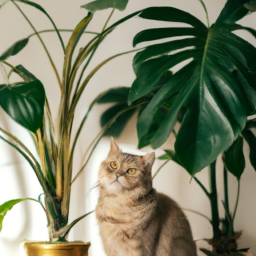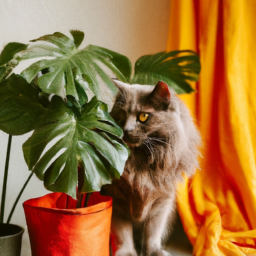
Are you a cat lover who also enjoys having indoor plants? If so, you may have wondered which plants are safe for your furry friend. In this blog post, we will explore the world of indoor plants that are cat safe. We understand the importance of creating a safe and harmonious environment for both your plants and your beloved pet. So, let’s dive in and discover some beautiful and cat-friendly plants that you can confidently bring into your home.
Benefits of Indoor Plants that are Safe for Cats
Indoor plants not only add beauty to our homes but also provide numerous benefits for our overall well-being. However, as cat owners, it is crucial to ensure that the plants we choose are safe for our feline friends. In this guide, we will explore the benefits of indoor plants that are cat-safe and how they can positively impact both our homes and our beloved pets.
Improved Air Quality
One of the significant advantages of having indoor plants is their ability to purify the air we breathe. Plants naturally absorb carbon dioxide and release oxygen through the process of photosynthesis. This not only helps us but also benefits our cats who spend most of their time indoors.
Indoor plants such as the Spider Plant, Boston Fern, and Areca Palm are not only safe for cats but also act as natural air purifiers. These plants can effectively remove harmful toxins such as formaldehyde, benzene, and xylene from the air, creating a healthier environment for both humans and cats.
Furthermore, plants release moisture vapor into the air through a process called transpiration. This helps to increase humidity levels, reducing the risk of dry skin and respiratory issues for both humans and our feline companions.
Stress Reduction
Living with indoor plants can significantly reduce stress levels for both humans and cats. Studies have shown that being around plants can promote relaxation and improve our overall mood. Cats, known for their ability to sense our emotions, can also benefit from the calming effect of indoor plants.
Plants such as Lavender, Valerian, and Catnip have natural sedative properties that can help to soothe anxious cats. Their pleasant scents and textures can provide a sense of comfort and security, reducing stress-related behaviors such as excessive meowing or scratching.
Creating a designated area with cat-safe plants not only enhances the aesthetic appeal of our homes but also serves as a peaceful retreat for our feline friends. This dedicated space allows cats to explore, play, and relax, providing mental stimulation and improving their overall well-being.
Natural Indoor Playground
Indoor plants can serve as a natural playground for our curious and energetic feline companions. Cats are instinctively drawn to the textures, shapes, and movement of plants, making them a great source of entertainment and exercise.
Providing climbing opportunities with cat-safe plants like the Cat Palm or the Spider Plant can help cats satisfy their natural instincts. Hanging plants such as the Boston Fern or the String of Pearls can also engage cats in playful swatting and jumping, keeping them physically active and mentally stimulated.
It is important to ensure that the plants we choose are non-toxic to cats, as some plants can be harmful if ingested. By creating a safe and enriching indoor environment, we can encourage our cats to engage in natural behaviors while minimizing the risk of accidents or poisoning.
In conclusion, incorporating indoor plants that are safe for cats into our homes can bring numerous benefits. From improving air quality to reducing stress levels and providing a natural playground, these plants contribute to a healthier and happier living environment for both humans and our feline companions. So go ahead, choose cat-safe plants, and create a harmonious space that nurtures the well-being of everyone in your home.

Indoor Plants Cat Safe
2. Popular Cat-Friendly Indoor Plants
Indoor plants not only add beauty and freshness to our homes but also provide numerous health benefits. However, if you have a furry friend at home, it’s essential to ensure that the plants you choose are safe for your cat. Some plants can be toxic to cats if ingested, causing various health issues. In this guide, we will explore popular cat-friendly indoor plants that you can confidently include in your home decor.
1. Spider Plant (Chlorophytum comosum)
The Spider Plant is a popular choice for indoor gardening enthusiasts and pet owners alike. This resilient plant is not only visually appealing but also safe for cats. It features long, arching leaves with green and white stripes, giving it a unique and attractive appearance.
Spider Plants are non-toxic to cats, making them an excellent addition to any cat-friendly household. However, if your cat tends to nibble on plants, it’s still a good idea to place the Spider Plant out of their reach to avoid any discomfort or digestive issues.
To care for a Spider Plant, place it in a well-lit area, but avoid direct sunlight. Water it regularly, allowing the soil to dry out slightly between waterings. Spider Plants are known for their ability to purify the air, making them a fantastic choice for improving indoor air quality.
2. Boston Fern (Nephrolepis exaltata)
The Boston Fern is a classic houseplant known for its lush, feathery fronds. Not only does it add a touch of elegance to any room, but it is also safe for cats. This plant thrives in humid environments, making it an ideal choice for bathrooms or kitchens.
Despite its delicate appearance, the Boston Fern is non-toxic to cats, making it a worry-free option for pet owners. However, keep in mind that cats might be tempted to play with the fronds, so it’s essential to monitor their interaction with the plant.
To care for a Boston Fern, place it in a bright, indirect light location. Keep the soil consistently moist but not waterlogged. Misting the fronds regularly can help maintain the humidity levels the plant requires.
3. Areca Palm (Dypsis lutescens)
The Areca Palm, also known as the Butterfly Palm, is a popular choice for indoor landscaping due to its graceful appearance and air-purifying qualities. This palm species is safe for cats, making it an excellent addition to any cat-friendly home.
The Areca Palm features long, feathery fronds that create an elegant and tropical atmosphere. It thrives in bright, indirect light and requires regular watering to keep the soil evenly moist. However, overwatering can lead to root rot, so it’s important to find the right balance.
Having an Areca Palm in your home not only adds a touch of natural beauty but also helps improve air quality by removing toxins from the environment. This makes it beneficial for both you and your feline companion.
Remember, while these plants are considered safe for cats, individual sensitivities may vary. It’s always a good idea to observe your cat’s behavior around any new plant and consult a veterinarian if you notice any unusual symptoms or concerns.
By choosing cat-friendly indoor plants, you can create a beautiful and safe environment for both you and your feline friend. Enjoy the benefits of indoor gardening while providing a stimulating and visually appealing space for your cat to explore.

Tips for Creating a Cat-Safe Indoor Plant Environment
As a cat owner, it’s important to create a safe and stimulating environment for your furry friend. Indoor plants not only add beauty to your home but also provide numerous benefits such as purifying the air and reducing stress. However, some plants can be toxic to cats, so it’s crucial to choose cat-safe indoor plants. In this article, we will provide you with a step-by-step guide on how to create a cat-safe indoor plant environment.
Choose Non-Toxic Plants
When selecting indoor plants for your cat-friendly home, it’s essential to choose plants that are non-toxic to cats. There are several varieties of plants that are safe for cats and can be easily incorporated into your indoor space. Some popular cat-safe plants include:
Spider Plant (Chlorophytum comosum): Spider plants are not only safe for cats but also act as natural air purifiers. They are easy to care for and can thrive in various lighting conditions.
African Violet (Saintpaulia): African violets are known for their beautiful flowers and non-toxic properties. They are perfect for brightening up any indoor space while keeping your cat safe.
Areca Palm (Dypsis lutescens): Areca palms are safe for cats and can add a tropical touch to your home. They require bright, indirect light and regular watering to thrive.
These are just a few examples of cat-safe plants, but there are many more options available. Before purchasing any new plant, always double-check its toxicity status to ensure it is safe for your feline companion.
Place Plants in Safe Locations
Once you have chosen cat-safe indoor plants, it’s important to place them in locations that are safe for your cat. Cats are curious creatures and may be tempted to nibble on plants or play with their leaves, so it’s crucial to take precautions to prevent any accidents.
Consider placing tall plants on elevated surfaces such as shelves or hanging them from the ceiling using macrame hangers. This will keep them out of your cat’s reach while still allowing you to enjoy their beauty. Alternatively, you can create designated cat-free zones where you can display your plants without worrying about your furry friend getting into trouble.
It’s also essential to avoid placing plants near your cat’s food and water bowls. Cats can be messy eaters, and you wouldn’t want any plant debris falling into their food or water, potentially causing digestive issues.
Provide Cat-Friendly Alternatives
While it’s important to create a cat-safe indoor plant environment, it’s equally important to provide your cat with alternative options to satisfy their natural instincts. Cats are known for their love of chewing on plants, so offering them cat-friendly alternatives can help redirect their attention.
Consider incorporating cat grass into your indoor space. Cat grass, such as wheatgrass or oat grass, is safe for cats to nibble on and provides them with essential nutrients. It can also help with their digestion and prevent them from munching on your precious indoor plants.
In addition to cat grass, provide your cat with interactive toys, scratching posts, and climbing trees to keep them mentally and physically stimulated. This will help reduce their desire to explore and potentially damage your plants.
Remember to regularly monitor your cat’s behavior around plants and make adjustments as needed. If you notice your cat showing excessive interest in a particular plant, it may be best to remove it from their environment altogether.
Conclusion
Creating a cat-safe indoor plant environment is essential for the well-being of both your cat and your plants. By choosing non-toxic plants, placing them in safe locations, and providing cat-friendly alternatives, you can create a harmonious living space where both you and your feline companion can thrive. Remember to always research the toxicity of any new plants before introducing them into your home, and consult with a veterinarian if you have any concerns about your cat’s behavior or health.
In a Nutshell
Indoor plants are a great way to add a touch of nature to your home, but if you’re a cat owner, you may have concerns about the safety of certain plants. Cats are curious creatures, and their nibbling habits can sometimes lead to trouble. But fear not, because there are plenty of beautiful and cat-safe indoor plants that you can enjoy without worrying about your feline friend’s well-being.
One of the safest options is the spider plant (Chlorophytum comosum). Not only is it non-toxic to cats, but it’s also a breeze to care for. Its long, arching leaves are appealing to cats, and even if they decide to give it a nibble, it won’t harm them. Another cat-friendly plant is the Boston fern (Nephrolepis exaltata). This lush green beauty is not only safe for cats but also acts as a natural air purifier, making it a win-win for both you and your furry companion. Other safe options include the Areca palm, Christmas cactus, and the African violet. Just be sure to keep an eye on your cat’s behavior around plants and provide alternative toys or scratching posts to redirect their attention if needed. With these cat-safe indoor plants, you can create a harmonious and green space that both you and your cat can enjoy.
Frequently Asked Questions (FAQ):
Q1: Are there indoor plants that are safe for cats?
A1: Yes, there are several indoor plants that are safe for cats. These plants are non-toxic and won’t harm your furry friend if they decide to take a nibble. It’s important to choose cat-safe plants to ensure the well-being of your pet.
Q2: Which indoor plants are safe for cats?
A2: Some popular indoor plants that are safe for cats include the spider plant, Boston fern, Areca palm, and the money plant (Pilea peperomioides). These plants are not only safe for cats but also add a touch of greenery to your indoor space.
Q3: How can I make my indoor plants cat-safe?
A3: To make your indoor plants cat-safe, you can take a few precautions. First, avoid bringing toxic plants into your home, as they can be harmful if ingested by your cat. Additionally, you can place your plants in areas that are out of your cat’s reach or use hanging baskets to keep them away from curious paws. Regularly inspect your plants for any signs of damage or wilting, as some plants may become toxic if they start to deteriorate.
Q4: What are the signs that a plant may be toxic to cats?
A4: Some common signs that a plant may be toxic to cats include drooling, vomiting, diarrhea, difficulty breathing, excessive thirst, and changes in behavior. If you notice any of these symptoms in your cat after they have come into contact with a plant, it’s important to seek veterinary care immediately.
Q5: Can cats still enjoy indoor plants if they are not cat-safe?
A5: While it’s best to avoid exposing your cat to toxic plants, you can still provide them with alternative ways to enjoy indoor greenery. Consider getting cat-friendly grass or catnip plants, which are safe and enjoyable for cats. These plants can satisfy their natural instincts and provide them with a safe and stimulating environment.
Dr. Olivia Green is a botanist with over two decades of experience in indoor plant cultivation. She holds a Ph.D. in Plant Biology and has dedicated her career to researching plant behavior in controlled environments. Dr. Green is passionate about helping plant enthusiasts master the art of indoor gardening through her extensive knowledge and practical insights.


